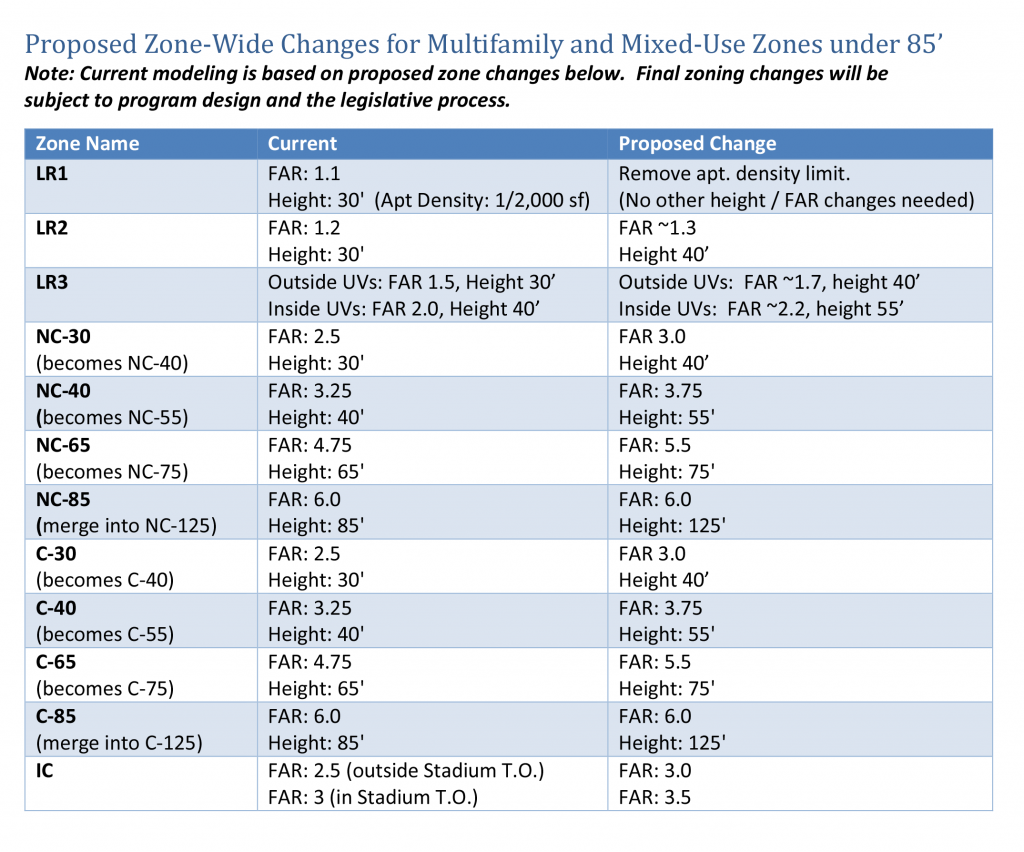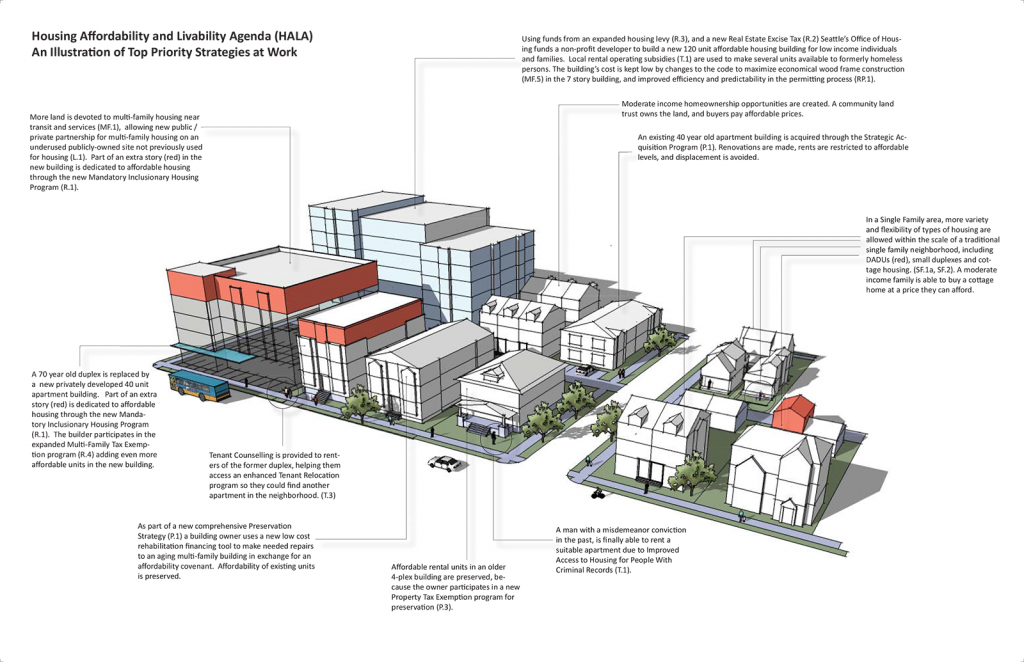

On Wednesday the Seattle City Council will hold a public hearing on recommendations to increase the city’s amount and variety of affordable housing options. Over the past year, the Housing Affordability and Livability Agenda Advisory Committee (HALA) has been working to develop land use and housing program policies that will fulfill Mayor Ed Murray’s goal for 50,000 new housing units – 40 percent of those “affordable” – over the next 10 years.
This will address the type of housing shortage Seattle hasn’t seen since World War II; at best, the city produces 800 units per year that can be considered affordable for lower-income people. The mayor directed HALA to find solutions for people earning various fractions of the area median income (AMI). AMI is adjusted based on family size and established by the federal Department of Housing and Urban Development. Typically, a housing unit is considered “affordable” if its costs (rent/mortgage and utilities) are no more than 30 to 35 percent of the occupants’ combined incomes. Housing units could be anything from apartments to backyard cottages, duplexes, and townhouses.
The Seattle Office of Housing has summarized what local AMI and affordable rents are for its various programs, with one set of requirements in the graphic below. Consider the example of a couple making $43,020 per year – 60 percent AMI. Including utilities, an affordable 1-bedroom unit for this couple would cost $1,008 per month. They’d be hard pressed to find a privately-owned apartment for that low of a cost anywhere near the downtown jobs center or within easy walking distance of commercial services and transit. HALA aims to provide both public and private options so this couple and others like them can live closer to where they work and shop.

In the interests of community and equity, HALA organized its work around four key principles: generating more public funding for affordable units; increasing the quantity of available housing; support for vulnerable buildings, homeowners and tenants; and streamlining development and permitting processes. The final 65 recommendations, compiled in a 76 page document (PDF), are meant to be implemented as a package rather than individually. The 19 most progressive recommendations are summarized here, headed by their numbers.
Mandatory inclusionary upzones and linkage fees
R.1 HALA recognizes that the private development market is no longer producing affordable units on its own. It proposes raising building height limits in multifamily and commercial zones – enabling greater rental incomes for developers and property owners – in exchange for one of two options: designate 5 to 7 percent of their building’s units as affordable at or below 60 percent AMI for 50 years; or pay into a public fund that will be used to build affordable units elsewhere.
In commercial zones, developers could either add affordable housing to their project or pay into that public fund based on the size of their commercial building. The public fund contribution requirements, if chosen, would vary based on the value of the upzones and the type of construction. This policy alone would lead to an estimated increase of 6,000 new affordable units over ten years.

Land use and zoning changes
SF.1 Increase the supply of accessory dwelling units (ADUs, such as basement apartments) and backyard cottages (detached ADUs, or DADUs) by removing code barriers like parking requirements, allowing both the primary and accessory units to be rented, and allowing a single lot to have both types of accessory units. Only 159 DADUs have been built since they were legalized in 2010. HALA also suggests developing pre-approved plans for backyard cottages and a clemency program for undocumented accessory units.
SF.2 Allow a broader mix of low-density housing in single-family areas. HALA suggests allowing small lot dwellings, cottages, courtyard housing, rowhouses, duplexes, triplexes, and stacked flats within the same building envelope required of single-family homes.
L.1 Prioritize the use of underutilized and surplus public land for affordable housing. Where land is not suitable for residential development, HALA suggests using the revenue from surplus sales to fund affordable housing. Mandate that housing be built in conjunction with new public amenities like libraries, community centers, and schools.
MF.1 Expand multifamily zoning in areas with amenities like transit service and schools, and to tie those expansions to mandatory requirements like those described in R.1.
MF.2 Expand the boundaries of urban villages, which are the areas where Seattle has been directing population and employment growth for the past 20 years while preserving outlying single-family residential areas. These areas are prioritized for infrastructure investment. It proposes expanding boundaries to areas within a 10 minute walk of transit service, and also around areas with schools, parks, and community centers.
MF.3 Upzone single-family lots within urban villages to Residential Small Lot or Lowrise, allowing for greater flexibility in housing types. There are 6,500 single-family parcels (totaling 800 acres) within urban villages that could better utilize high capacity infrastructure.

Proactive preservation strategies
P.1 Publicly acquire existing multifamily properties that are affordable for the the neighborhood but are at risk of redevelopment.
P.2 Make strategic public infrastructure investments in neighborhoods and cultural communities that are vulnerable to displacement. HALA says these areas should be targeted for economic development, parks, and transit funding.
P.3 Lobby the state legislature for a property tax exemption for private landlords who agree to income restrictions and rent limits, particularly where marginalized populations would most benefit. This would be targeted to properties most at risk for rent increases that will price out tenants.
Financial resources
R.2 Lobby the state legislature to allow for an additional 0.25 percent Real Estate Excise Tax (REET) that would become a relatively stable source of funding for affordable housing programs. Currently King County collects a REET on property sales at the maximum rate allowed under state law: 1.78 percent.
R.3 Renew and double the Seattle Housing Levy that helps build and preserve housing, along with providing rental subsidies, for people at risk for homelessness, first-time home buyers, and extremely low-income households. Historically Seattle voters have approved this property tax levy five times, the last time being in 2009 for a $145 million levy that expires in 2016.
R.4 Renew and and expand the Multifamily Tax Exemption (MTFE) program. This program provides a property tax exemption to market-rate and nonprofit properties where at least 20 percent of units are affordable to renters at 65 to 85 percent AMI. HALA also suggests expanding the applicability of the MTFE to all multifamily zones, expanding the amount of qualifying unit types and promoting family-sized units, and pushing state legislation to permit the exemption to last more than 12 years
R.6 Lobby the state legislature to expand the State Housing Trust Fund. This fund is dedicated to people with special needs, seniors, and people with disabilities at or below 30 percent AMI.
R.7 Reinstate the City Growth Fund, which was originally established in 1985 to address the loss of low-income housing in downtown. It was created from new property tax revenues tied to new construction but was discontinued in 2002.
Tenant support
T.1 Pursue local legislation, education, and technical assistance to ensure fair access for people with criminal records. HALA cites data showing that 25 to 33 percent of U.S. adults have a criminal record, and they are disproportionately people of color with low incomes.
T.2 Explore City funding to expand rental and operating subsidies for extremely low income tenants. The report says that traditional federal funding (Section 8 vouchers) addresses less than 25 percent of local needs for public housing operations.
Streamline development processes
RP.1 Reform the Design Review and Historic Review processes. Builders and designers report that discretionary review by boards made up local residents adds significant costs and complexity to multifamily projects, with an average project taking 14 months from permit application to permit issuance. HALA suggests better two-way dialogue, training for review board members, and limiting the number of meetings.
RP.2 Raise the threshold for review under the State Environmental Policy Act (SEPA). HALA found that Seattle’s codes regarding environmental critical areas, shorelines, grading and drainage, stormwater regulations, and other codes address most of the issues in a SEPA review. HALA also finds SEPA has little effect on the outcome of construction projects and that it is used more to obstruct than promote sustainable development.
Public hearing on Wednesday
The Urbanist has published a call to action to support these and the other recommendations at a public hearing on Wednesday, September 9th . The Seattle City Council will hold spoken testimony Wednesday at 5:30 P.M. at City Hall (600 4th Ave, Floor 2, Seattle, WA 98104) and can be e-mailed any time at council@seattle.gov. Future updates will cover the public feedback and the movement of these policies through the political pipeline.
Scott Bonjukian has degrees in architecture and planning, and his many interests include neighborhood design, public space and streets, transit systems, pedestrian and bicycle planning, local politics, and natural resource protection. He cross-posts from The Northwest Urbanist and leads the Seattle Lid I-5 effort. He served on The Urbanist board from 2015 to 2018.

